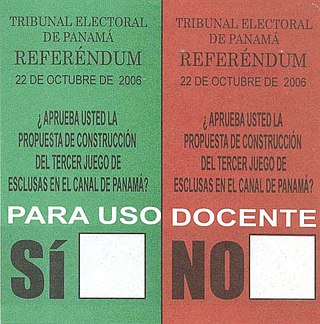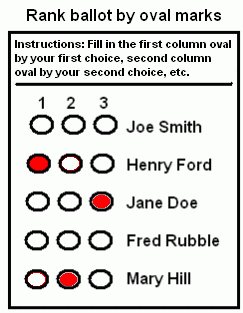
An election is a formal group decision-making process whereby a population chooses an individual or multiple individuals to hold public office.

Plurality voting refers to electoral systems in which the candidates in an electoral district who poll more than any other are elected.

Proportional representation (PR) refers to any type of electoral system under which subgroups of an electorate are reflected proportionately in the elected body. The concept applies mainly to political divisions among voters. The essence of such systems is that all votes cast – or almost all votes cast – contribute to the result so that each representative in an assembly is mandated by a roughly equal number of voters, and therefore all votes have equal weight. Under other election systems, a bare plurality or a scant majority are all that are used to elect candidates. PR systems provide balanced representation to different factions, usually defined by parties, reflecting how votes were cast. Where only a choice of parties is allowed, the seats are allocated to parties in proportion to the vote tally or vote share each party receives.

Party-list proportional representation (list-PR) is a system of proportional representation based on preregistered political parties, with each party being allocated a certain number of seats roughly proportional to their share of the vote.

The two-round system, also called ballotage, top-two runoff, or two-round plurality, is a single winner voting method. It is sometimes called plurality-runoff, although this term can also be used for other, closely-related systems such as instant-runoff voting or the exhaustive ballot. It falls under the class of plurality-based voting rules, together with instant-runoff and first-past-the-post (FPP). In a two-round system, if no candidate receives a majority of the vote in the first round, the two candidates with the most votes in the first round proceed to a second round where all other candidates are excluded. Both rounds are held under choose-one voting, where the voter marks a single favored candidate.

The single transferable vote (STV) or proportional-ranked choice voting (P-RCV) is a multi-winner electoral system in which each voter casts a single vote in the form of a ranked ballot. Voters have the option to rank candidates, and their vote may be transferred according to alternative preferences if their preferred candidate is eliminated or elected with surplus votes, so that their vote is used to elect someone they prefer over others in the running. STV aims to approach proportional representation based on votes cast in the district where it is used, so that each vote is worth about the same as another.

Single non-transferable vote or SNTV is an electoral system used to elect multiple winners. It is a semi-proportional variant of first-past-the-post voting, applied to multi-member districts where each voter casts just one vote. It can also be seen as a variant of limited voting where each elector votes only once.

Voting refers to the process of choosing officials or policies by casting a ballot, a document used by people to formally express their preferences. Republics and representative democracies are governments where the population chooses representatives by voting.

In the study of electoral systems, the Droop quota is the minimum number of votes a party or candidate needs to receive in a district to guarantee they will win at least one seat.

Mixed-member proportional representation is a type of representation provided by some mixed electoral systems which combine local winner-take-all elections with a compensatory tier with party lists, in a way that produces proportional representation overall. Like proportional representation, MMP is not a single system, but a principle and goal of several similar systems. Some systems designed to achieve proportionality are still called mixed-member proportional, even if they generally fall short of full proportionality. In this case, they provide semi-proportional representation.

The quota or divide-and-rank methods make up a category of apportionment rules, i.e. algorithms for allocating seats in a legislative body among multiple groups. The quota methods begin by calculating an entitlement for each party, by dividing their vote totals by an electoral quota. Then, leftover seats, if any are allocated by rounding up the apportionment for some parties. These rules are typically contrasted with the more popular highest averages methods.

A random ballot or random dictatorship is a randomized electoral system where the election is decided on the basis of a single randomly-selected ballot. A closely-related variant is called random serialdictatorship, which repeats the procedure and draws another ballot if multiple candidates are tied on the first ballot.

In political science, parallel voting or superposition refers to the use of two or more electoral systems to elect different members of a legislature. More precisely, an electoral system is a superposition if it is a mixture of at least two tiers, which do not interact with each other in any way; one part of a legislature is elected using one method, while another part is elected using a different method, with all voters participating in both. Thus, the final results can be found by calculating the results for each system separately based on the votes alone, then adding them together. A system is called fusion or majority bonus, another independent mixture of two system but without two tiers. Superposition is also not the same as "coexistence", which when different districts in the same election use different systems. Superposition, fusion and coexistence are distinct from dependent mixed electoral systems like compensatory (corrective) and conditional systems.
An electoraldistrict, sometimes called a constituency, riding, or ward, is a geographical portion of a political unit, such as a country, state or province, city, or administrative region, created to provide the voters therein with representation in a legislature or other polity. That legislative body, the state's constitution, or a body established for that purpose determines each district's boundaries and whether each will be represented by a single member or multiple members. Generally, only voters (constituents) who reside within the district are permitted to vote in an election held there. The district representative or representatives may be elected by single-winner first-past-the-post system, a multi-winner proportional representative system, or another voting method.

Instant-runoff voting is a single-winner, multi-round elimination rule that uses ranked voting to simulate a series of runoff elections. In each round, the candidate with the fewest first-preferences is eliminated. This continues until only one candidate is left. Instant runoff falls under the plurality-with-elimination family of voting methods, and is thus closely related to rules like the two-round runoff system.
Electoral reform is a change in electoral systems which alters how public desires are expressed in election results.

Semi-proportional representation characterizes multi-winner electoral systems which allow representation of minorities, but are not intended to reflect the strength of the competing political forces in close proportion to the votes they receive. Semi-proportional voting systems are generally used as a compromise between complex and expensive but more-proportional systems and simple winner-take-all systems. Examples of semi-proportional systems include the single non-transferable vote, limited voting, and parallel voting.

An electoral or voting system is a set of rules used to determine the results of an election. Electoral systems are used in politics to elect governments, while non-political elections may take place in business, non-profit organisations and informal organisations. These rules govern all aspects of the voting process: when elections occur, who is allowed to vote, who can stand as a candidate, how ballots are marked and cast, how the ballots are counted, how votes translate into the election outcome, limits on campaign spending, and other factors that can affect the result. Political electoral systems are defined by constitutions and electoral laws, are typically conducted by election commissions, and can use multiple types of elections for different offices.

Ranked voting is any voting system that uses voters' rankings of candidates to choose a single winner or multiple winners. More formally, a ranked system is one that depends only on which of two candidates is preferred by a voter, and as such does not incorporate any information about intensity of preferences. Ranked voting systems vary dramatically in how preferences are tabulated and counted, which gives them very different properties. In instant-runoff voting (IRV) and the single transferable vote system (STV), lower preferences are used as contingencies and are only applied when all higher-ranked preferences on a ballot have been eliminated or when the vote has been cast for a candidate who has been elected and surplus votes need to be transferred.

Mixed-member majoritarian representation (MMM) is type of a mixed electoral system combining winner-take-all and proportional methods, where the disproportional results of the winner-take-all part are dominant over the proportional component. Mixed member majoritarian systems are therefore categorized under semi-proportional representation, and are usually contrasted with mixed-member proportional representation (MMP) which aims to provide proportional representation compensation ("top-up") seats.








